By Dan McWilliams
At 10:50 on the morning of July 27, Father David Carter’s voice rang out at Mount Olivet Cemetery in Chattanooga: “We are about to lift the coffin from the grave.”
And with that, the sainthood cause of Servant of God Father Patrick Ryan took a crucial step, as the exhumation of his remains for re-entombment at the Basilica of Sts. Peter and Paul could proceed.
Bishop Richard F. Stika attended the exhumation of the former Sts. Peter and Paul pastor, who died in 1878 in the yellow-fever epidemic in Chattanooga as he selflessly ministered to victims of the plague that would eventually claim his own life.
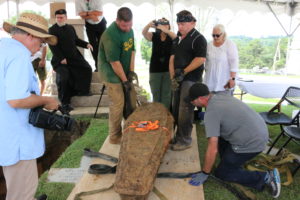
Father Ryan’s coffin is lifted from its grave and rested on top of the ground in Mount Olivet cemetery as the important moment is recorded by cameras.
Father Carter, rector of the basilica and episcopal delegate for the sainthood cause, was present at the digging along with a team of experts and witnesses. That team included Dr. Barbara Golder, a physician and medical witness, and Deacon David Keene, an archeologist with the Archdiocese of Chicago.
Also there were Deacon Gaspar DeGaetano and Deacon Hicks Armor of the basilica parish, as well as diocesan chancellor Deacon Sean Smith. Deacon DeGaetano is the diocesan postulator for the sainthood cause, and Deacon Armor is a notary for the cause. Father John Orr, pastor of St. Mary Parish in Athens, attended as the promoter of justice for the cause. Adjunct notary Becky Dempsey attended, too. Jim Wogan, diocesan communications director, took video of the three-day exhumation as part of the official record of the cause of sainthood and photographer Stephanie Richer took detailed photographs for the same purpose.
Ninety-degree-plus temperatures made the work of the gravediggers, which began July 26 and concluded very late the next day, especially arduous. Diggers toiled for some five hours on the first day before finally reaching Father Ryan’s coffin eight feet down below Priests’ Mound at Mount Olivet at about 3 p.m. The cast-iron coffin is in the old-fashioned diamond shape—wide at the shoulders and tapering off to narrower at the feet. Those present July 26 were the first to see the coffin in 135 years, as Father Ryan was reburied in 1886 from a downtown cemetery to the then-new Mount Olivet. The priest was the first person to be buried in the new cemetery.
“We started digging about 10 in the morning [on July 26],” Deacon DeGaetano said. “They had a break for lunch, and then they continued digging in the afternoon. We found what seemed to be a little votive garden only about 3 feet underground. There were what looked like carved pots for flowers or votive candles, and kind of a concrete thing that might have been a shrine—it’s hard to tell what it was. It might have even been in the shape of a cross. We’re not sure yet, but we’re going to bring the pieces back to the basilica and use them for something, maybe even a memorial rock garden, because it’s hard to figure out what they are. It’d be a shame to just bury them again. We also found pieces of glass, like there might have been votive candles used there.”
The laborers “kept digging and digging and digging,” the deacon said. “We had hopes that he was buried in a very substantial casket or coffin. Then about 3 o’clock I was texting somebody, saying, ‘We’ve got to keep praying. We haven’t found Father Ryan.’ Then, son of a gun, they said, ‘We hit something.’ Then we just saw part of a coffin. At first we thought it was a child’s coffin, but it turns out it’s a full-sized coffin of the day. It turns out that cast-iron coffins were the premium way to get buried.”
Painstaking work resumed at 9:30 a.m. on July 27 as volunteer gravediggers Brandon and Nelson Panganiban, members of Father Patrick Ryan Knights of Columbus Council 610 at the basilica, labored with trowels and other tools to remove dirt around and below the casket and prepared it to be lifted up by an excavator. Concrete burial vaults of neighboring priests’ graves protruded slightly into the pit dug for Father Ryan’s, one about 3 feet down on the right and another about 6 feet down on the left.
Nelson Panganiban said partway through the removal of the remains that there was “not much air and heavy dirt” in the grave. “The casket seems to be in great shape, just trying to dig around it and get him up.”
The muscular Mr. Panganiban said he “just volunteered for the Knights to help out” with the digging.
Excavator operator Frank Brogden of the Mount Olivet staff, assisted by his son Frank Jr., delicately removed soil on and around the coffin. Straps were placed around the coffin and a chain was hooked up to the excavator, which lifted the coffin gradually to the surface around 11:45 a.m. Meanwhile, Cardinal Timothy Dolan, archbishop of New York, happened to telephone a few minutes before, and Bishop Stika gave him a report of the day’s events.
Cardinal Justin Rigali, in Knoxville, was also an eyewitness to the exhumation via Bishop Stika’s cell phone.
Father Carter led a prayer after the coffin was removed, as well as a round of applause for the gravediggers and Mr. Brogden.
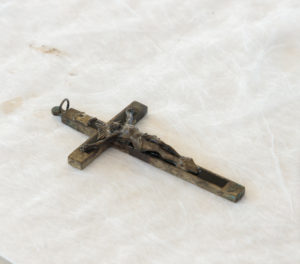
Among the second-class relics found with Father Ryan’s remains was a small crucifix with which he was buried. The priest’s vestments also were discovered.
Bishop Stika also conducted a prayer, “that the people of God might be edified by the heroic example of this faithful priest, and that the hearts of many might be drawn closer to you, the Divine Shepherd of our souls, as we hold up the example of one who sought to imitate his pastoral ministry in this community. We give thanks for the life of Father Ryan and for all those priests who have given their lives throughout the epidemic of yellow fever in that era.”
The work was not yet done, however.
The coffin was sealed with a number of metal bolts every few inches all the way around. Cemetery staffers with handheld grinders cut the bolts and then drilled out the holes. The lid was still tightly closed, perhaps rusted shut, so more work with the grinders at the edge of the lid followed, as did efforts with crowbars. Gray, pungent water poured out of the foot of the coffin as the sawing progressed.
Finally, at 1:50 p.m., the lid was opened. The first thing witnesses noticed inside the coffin was broken glass from the metal box’s viewing window, control knobs for which were on top of the coffin. As Deacon Keene narrated the process of removal for everyone, a mandible with teeth and a skull were soon discovered, as well as a crucifix.
“What we’re going to do is follow the Instruction for the Relics of the Church: Authenticity and Preservation, that was given by the Congregation for the Causes of the Saints in 2017,” Father Carter said. “We will pull up the relics one by one. We have an archaeologist first, who will be doing the removal of the remains. Then a forensic pathologist and a forensic anthropologist will be on standby to identify the remains and to recompose them on a surface that’s prepared for him that will be going into a new coffin that we have prepared for his first-class relics: the mortal remains of his body.”
But around 2 p.m., Dr. Golder detected the possible presence of arsenic in the coffin, and the day’s efforts were suspended until the team could bring in environmental experts the next day.
Father Ryan’s remains and relics were stored overnight July 27-28 in the Mark J. O’Brien mausoleum near Priests’ Mound, which the O’Brien family had given the basilica staff permission to use.
Father Orr, the promoter of justice for the sainthood cause, has the unenviable job of “arguing against the canonization,” he said. “I’m here just to make sure that they’re not pushing any case here,” such as “if there were any roadblocks to his canonization.”
“It is tough because we don’t have a lot of writings of his. Oftentimes the promoter of justice will be going through so many different writings of the person being considered, but perhaps the only writings of his would have been entries into the baptismal record or the marriage record—the sacramental record books of Sts. Peter and Paul,” Father Orr added.
Father Ryan’s cause comes under a new third category of sainthood, Deacon DeGaetano explained.
“When we visited the Cause for the Saints just five years ago in April 2016 in Rome, we met with an American monsignor who was giving us some very good advice. He even gave us a heads-up on a new category, because Father Ryan was being called a martyr of charity in his day,” the deacon said. “What Monsignor Robert Sarno told us was that ‘the pope’s working on something like this for people who died serving in charity.’ And we found out only a couple of years ago when the bishop visited with the Cause for the Saints in Rome, they told him that they had our cause in mind when they developed the motu proprio with the pope. It’s only the third category of saint in the last 2,000 years. You always had martyr, then you had heroic life. Then in 2017 we have offering of life.”
Deacon DeGaetano said finding Father Ryan’s remains in the condition they are in was like a “dream come true.”
“Our hopes have been that we would find Father Ryan in good shape, and part of finding him in good shape would be that he would still be in the casket. And he is in an extremely sturdy casket. It was like the Rolls-Royce of the day. We did some research just recently on the price of a wooden coffin. The price of a wooden one would be $1 to $3 back then, and the price of a cast-iron one would have been about $100.”
Father Ryan’s coffin was originally about 6 feet down, the team of experts believes, with about 2 feet added on top over the years as Priests’ Mound was built up.
“The grave will never be used again, and the original stone marker will be placed again on it with a notation that his remains have been moved to the Basilica of Sts. Peter and Paul, the parish which at one time he was the pastor of, so let it be done,” Bishop Stika said.
The coffin had a cross-shaped crack on top, not believed to have been caused by the removal efforts, Deacon Keene pointed out. Its shape was coincidental, the deacon observed.
“Maybe God intended it to be a cross,” the bishop said.
The cause of Father Ryan’s sainthood is most important to the Diocese of Knoxville, Bishop Stika emphasized.
“It’s very significant. For a young diocese—we have a new cathedral, a basilica, and now this is so significant because a pastor of the parish of Sts. Peter and Paul is now a Servant of God, and we’re hoping soon that he will be declared venerable by the pope,” he said. “If we look at the life of a priest, in the Scriptures it said no greater thing than to give your life for one’s friends. At the time he died, he ministered to everyone, not just the Catholics, and Catholics in Chattanooga’s history back then were suspected to be papists, loyal to the pope and not loyal to the government of the United States. It just shows how he was beloved at his funeral and his reburial years later, that streets were lined with everyone, and the Catholic population then wasn’t even probably half a percent. That’s why it’s significant, because he was truly a priest’s priest. He served people—not just Catholics but people.”
The discovery of arsenic was part of the “unknowns” in the “uncovering of mortal remains,” Father Carter said.
“He’s been in the ground 135 years. When he went into the ground originally eight years even before that, they embalmed him apparently with arsenic,” he said. “It was a commonly used substance to embalm people before the modern practices of embalming were known, especially during a time when things like yellow fever were unknown pathogens that were killing people, so they didn’t take any chances.
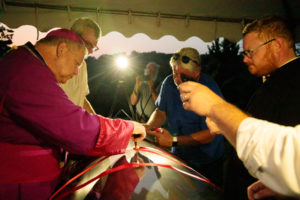
Bishop Stika, Father David Carter, Deacon Sean Smith, and Deacon Hicks Armor seal Father Ryan’s new casket.
“We did not know to suspect that. We did not have a reason to suspect it when we pulled him out of the ground. The coffin itself was intact. There was no water sloshing. We didn’t hear anything that sounded like water when we pulled it out. Didn’t even feel that heavy when we pulled it out, but when we did open it up, we saw that some water had gotten into it and was standing in it. After we started probing the remains and found some substantial relics, some intact bones, the medical examiner as she was looking at it put two and two together that bones that old sitting in water ought to have decayed a little bit more than they did. Seeing the chalky substance floating around was suspicious to her. She called the equation, when she put two and two together, that there was arsenic present, and we suspended operations at that point and have consulted with the Tennessee Department of Environment and Conservation, which has given us definitive guidance on the procedures that we need to follow, and we have contacted a hazardous-material remediation service, and they are mobilizing to assist us in the continuation of this exhumation and the recovery of these mortal remains while keeping everybody safe.”
Work on the removal of the remains from the coffin resumed July 28 with the environmental safety precautions in place. Father Carter recounted that Wednesday on July 31, after the memorial Mass and re-entombment of Father Ryan’s remains had taken place at the basilica.
“On Wednesday, after a long process of uncovering the remains and bringing them to the surface and doing what we had to do to preserve the mortal remains, we pulled out that which was remaining from his body from the coffin that he had been buried in. We laid them out in a new casket and prepared them for today’s translation of his remains to the church,” the basilica rector said.
“We found vestments that were still intact. We found an extra stole that may have been used in his ministry when he went door to door to visit the yellow-fever victims. We found a full set of bones. His bones were intact. The arsenic led to the preservation so well of his mortal remains. We had to call in a service that specialized in remediation of hazardous materials and environmental safety, and the professionals were the ones who took the remains out of the coffin and professionally treated them, washing them and handing them to our medical experts, who of course wore gloves and masks in an abundance of caution. They reconstructed his body in the new casket.”
Father Carter made a distinction between first- and second-class relics.
“First-class relics are the actual mortal remains of the saint or potential saint, and in our case we make a very clear distinction he’s a Servant of God. He’s not yet a saint, and that’s why we wore purple vestments today [at the memorial Mass], by the way, not white vestments. We’re making that distinction. We recognize him as what he is: a hero of the epidemic, the Servant of God. The first-class relics consist of his bones. We found a full skeleton from head to toe, obviously owing to the preservation in arsenic that happened at the time of his death, the embalming.
“In addition, we found lots of personal effects, including the vestments that he was buried in. We found his alb, the amice, the cincture. We found a crucifix that he was holding in his hand. We found his scapular of Our Lady that he was wearing underneath all of that, a very private devotion of many Catholics even to this day. Those are what we call second-class relics. In addition, the coffin that he was buried in itself is a second-class relic. The whole cast-iron coffin with its viewing port that they had becomes for us a second-class relic that we will eventually hope to put on display as part of a memorial for Father Ryan.”
On July 19, Bishop Stika and members of the team of experts met at Mount Olivet for a ceremonial turning-over of the earth on Father Ryan’s grave. The bishop did the honors with a shovel, digging out a large square of grass and dirt. Bishop Stika’s actions were the reverse of those of Nashville Bishop Joseph (James) Rademacher in 1886.
“Today is very significant because on Nov. 11, 1886, when Father Patrick Ryan was buried here, there was quite a bit of pomp and circumstance because he was the grand opening of this beautiful cemetery,” Deacon DeGaetano said. “There were at least 100 carriages, based on one account, and another account says hundreds of carriages came out from Chattanooga. When he was lowered into the grave, the bishop of Nashville at the time, who of course was bishop of the whole state, Bishop Rademacher, put in the first shovelful of dirt into the grave … after they lowered Father Ryan into the [grave]. We’d like to do that in reverse today, sort of a poetic symmetry, where Bishop Stika will do the opposite of what Bishop Rademacher did in the sense of taking the first shovelful of soil out of the grave.”
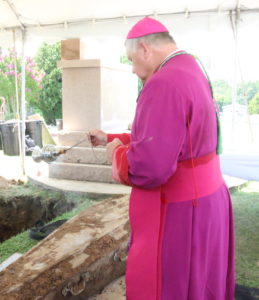
Bishop Stika incenses the coffin of Father Ryan after it was raised from its 135-year-old grave in Chattanooga’s Mount Olivet Cemetery.
After the brief ceremony, the bishop led a prayer, and Deacon Armor read from two Chattanooga newspaper reports and the register of the cemetery about the reinterment of Father Ryan in 1886.
A slight rain fell at that first day in the cemetery.
“Father Ryan, being born in the old country, the beautiful green country of Ireland—there’s an old tradition of the Irish, that when it rains it’s like the angels crying in sadness,” Bishop Stika said. “I think today, as we prepare during this next week to move his remains, the tears are of joy, for a man is being remembered fondly after so many decades, two centuries, in which we commemorate a man who never quit being a priest, ministering to Catholics and non-, during the terrible plague of yellow fever. I think the heavens rejoice this day. We give thanks to Almighty God for the memory of Father Ryan.
“In the inscription on his stone, it says, ‘Rest in peace’—well, this is the third time he is being moved. The third time and last. And yet it just reminds us that for all of us we live in a world that is passing. Father Ryan so many years ago passed from this life, from this journey that began in Ireland and ended in Chattanooga, then he passed to heaven. We rejoice, we celebrate, we express our gratitude for the ministry that he accomplished in his life as well as the ministry of all the priests here on this significant place of holiness, in this cemetery consecrated. Eternal rest grant unto him, O Lord, and let perpetual light shine upon him. May his soul and all the souls of the faithful departed, through the mercy of God, rest in peace. Amen. Father Ryan, we give thanks to you for your ministry, for your witness, and for your love of the people. We ask this through Christ, our Lord. Amen.”
Father Carter called it “a great joy and a privilege to have the presence of someone venerable in our community, someone who has been hailed as a hero and a martyr of charity. It means a lot for us to have the closeness of sanctity, especially in a time when the Catholic Church and in particular the Catholic priesthood is under such duress, to see a good example of a heroic priest doing his duty and giving his all like Christ.”

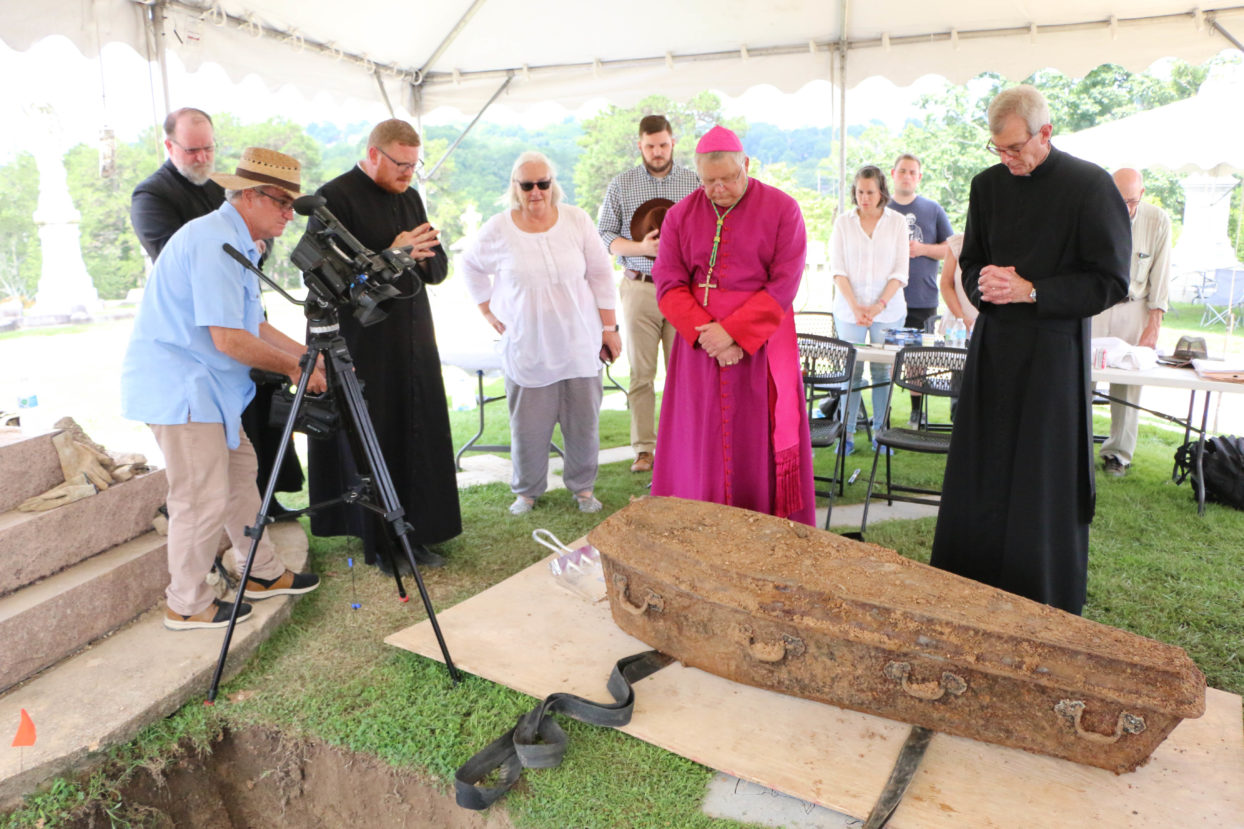
Comments 1
I am writing to request a 2nd – class relic of Father Patrick Ryan . As a devout Catholic, I have a deep devotion and devotion to Father Patrick Ryan .I believe that having a 2nd-class relic of this beloved saint will deepen y faith and spiritual life.
I understand that first-class relics are usually reserved for churches and religious institutions. However, as a faithful follower, I feel that owning a 2nd-class relic or Relic Card will further inspire me in my journey of faith.
I assure you that the relic will be treated with reverence and respect, and that it will be used only for personal prayer and devotion in my home. I am willing to bear any costs or fees associated with obtaining a 2nd-class relic.
Please let me know what steps I need to take to get the relic, and if there is any specific procedure I need to follow. I look forward to your prompt response, and I thank you in advance for your kind consideration.
and so that I can further spread the earlier holiness of his life and so that I can deepen my faith in him and in my community, May even if it is only a 3rd class relic if you give it, I will look at the faith in him with a whole heart of holiness .
and so that I can bring this relic card to the sick in our community, may they feel even more that god is with them in their lives.
Sincerely yours,
FROM : ELDRENE JOHN DELA CRUZ
MY ADDRESS: PHILIPPINES ST OSORIO 4861 AGNAYA PLARIDEL BULACAN